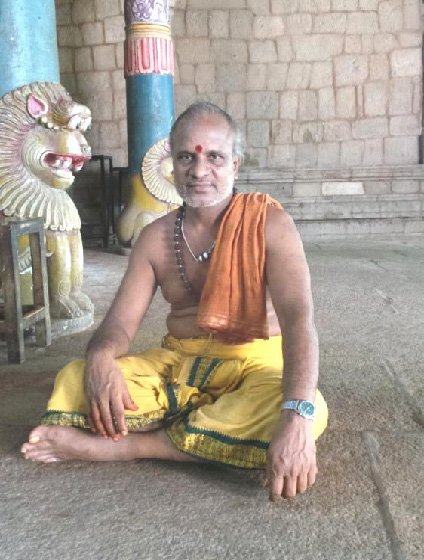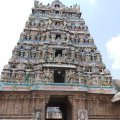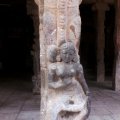Sculptures in temples in Kumbakonam: photo 574
Photo 574 of 640 in Gallery: Sculptures in temples in Kumbakonam

Image title: Figure 5. Siddhanatha Gurukkal
Description of the photo
An interview of the Gurukkal at the Durgai Amman Kovil on 30.10.2013 6
1. What is your name and designation Sir?
A. I am Siddhanatha Gurukkal. I am the head Arcakar here. My family has been serving here for the past 17 generations. We have served during the reigns of several kings. Ambal is taking care of us well ever since.
2. What do you say about the Murtis here?
A. Ambal is here Anugraha Murti and Sivan is Pradana Murti.
3. Can you tell something about the history of the temple.
A. Kamadhenu the divine cow is responsible for consecrating Sivan here. She received the boon from Siva here. Kamadhenu’s daughter Patti worshipped Sivan here and got Moksa. This place got the name Dhenupurisvarar (attached to Kamadhenu) or Pattisvaram [Pattisvara] (attached to the daughter). First one is the name of the Lord here and the second one is the name of the place meaning “Patti surrendered (Saranagati) to Isvara here”. Citrasena Maharaja, Markandeyar and Visvamitra came here and worshipped Sivan and got his grace.
This is also one of the important places where Sri Rama worshipped Sivan. Sri Rama had three Dosams or afflictions in his horoscope–
a. Viragatti Dosam [Dosa] which could be removed by worshipping Vinayaka.
b. Cayagatti Dosam [Dosa] which is–Rama killed Vali from behind. Though this act of Rama had a reason, it was an act of sin. As a Prayascita, Siva told Rama that if he worshipped him in this place then this sin could be pardoned. Rama is known to have come to this place and worshipped Siva. In the month of Margazhi on Amavasya night Isvara gave his Darsan to Rama here and his Dosam [Dosa] was removed.
This is also the Sthalam [Sthala] where Tirujnanasambandar composed his songs. When Tirujnanasambandar came here he was around 3 and a half years old. This three and a half year old child came here during afternoon hours in the scorching heat. Seeing this Lord Siva constructed a pearl canopy as shade and instructed that the child must be brought under the shade. The Bhutaganas went with the pearl canopy to bring Tirujnanasambandar and told him that the Lord had sent it. Siva willed that he should be able to see the child from where he stood. Hence in this temple Nandi, Vinayakar, Vannimaran, Balipitham are all slightly away from the centre line of the Sannidhi.
Besides this Cholas flourished from here. The Cholas had many capitals during their reign. One such capital was Pazhaiarai. It is believed that when Pazhaiarai was the Chola capital, that is the time Tirujnanasambandar came here. It is also believed that this temple was built much much before Raja Raja Chola. This is not just associated with the existing construction. Murti, Sthalam [Sthala] and Tirtham [Tirtha] was the definition of a temple in the olden days. That was so in a particular Yuga. Later in another Yuga the Kovil attained a small hutment like structure. Now in the Kaliyuga we can see such huge constructions which define a temple. So the belief is this temple existed much before this presently seen construction in a simpler form.
4. Can you tell something about the Durgai Amman here.
A. Here Durgai Amman is Santa Svarupa. She is in the form of Anugraha Murti. It is a very unusual Tirukkolam–her left hand is in Uru Hasta (placed on thigh) and there is a parrot in the same Uru Hasta. Goddess Minaksi has a parrot on her right shoulder. Kannikaparamesvari also has a parrot on her right shoulder. Andal has a parrot on her left shoulder. But here the goddess has a parrot on the Uru Hasta. Also the lion’s face is on the left side. This is associated with the Santa Svarupam. In the Ugra Tirukkolam, the lion’s face is always shown on the right. The lion is residing here as Dharmam. Below the parrot is the lion and below the lion is the head of a human being. Here Ambal is in Tribhangam.
“Dukha Nivarani Durga–this is the special power that Paramesvara has bestowed upon Durga. Due to agitation of the mind, accumulation of worries results in ill health of human beings which needs different medicines. If these worries and troubles can be removed each day then it will result in happiness. This power has been bestowed upon Ambal. So this is called as “Sarva Dosa Nivarana Sthalam’. She is in a standing posture.
5. How many Bhujams does Durgai Amman have?
A. She has Astabhujam. Main right and left hands are in Abhaya and Uru Hasta with Suka (parrot). Rest of the back right and left hands have Cakra/ Sankha, Dhanus/ Bana, Khadga/ Khetaka.
6. How is the Utsava Murti of Amman?
A. It is the same as the Mulavar.
7. Is there any special Vimana for Ambal?
A. Yes it is called as Manonmani Vimanam. All Ambal Vimanam” s have the same name and special structure.
8. Which direction does this temple face? How many entrances are there in this temple?
A. This temple faces north direction. There are 4 entrances in the entire temple. All the Gopurams are exactly in the four directions. Main temple is Siva’s (Sivalaya). Siva has given a separate Sannidhi for Durgai.
9. Which direction does Sivan” s Sannidhi face?
A. East.
10. How many Prakarams are there in this temple?
A. There are 3 Pakarams for Siva and Durgai Amman Sannidhi is in the third Prakaram [Prakara].
11. What is present in each Prakaram?
A. In the first Prakaram all Siva’s Avarna Daivangal are present like Daksinamurti, Lingotbhava, Saptamata, Gajalaksmi. Second Prakaram has Bhairavar, Swarna Vinayakar etc. In the third Prakaram–Dhvajasthambam, Balipitam, Periya Nandi, Madhavarna Pillaiyar, Murugan, Durgai are all there.
12. What is the purpose of Durgai Amman?
A. Paramesvara” s wife is Parasakti. Parasakti takes different Avatarams to perform different functions. In Kaliyuga, Paramesvara has bestowed Durgai Amman and Vinayakar with specific powers to execute. In most places these two idols are
present together. The belief is that Vinayaka and Ambal are together taking care of
Kaliyuga.
13. How many Mandapams does this temple have?
A. This temple has all Mandapams–Sabha Mandapam, Asthana Mandapam, Nrtya Mandapam, Vahana Mandapam, Vadya Mandapam, Snapana Mandapam, Angapradaksana Mandapam, Ardha Mandapam, Maha Mandapam [Mandapa] and so on–whatever Mandapam is needed in an Alaya, everything is present.
14. Which is the Sthala Vrksam [Vrksa] here? Which is the Puskarni attached with this temple?
A. Vanni Maram [Mara] which is present in Siva” s Sannidhi is the Sthala Vrksam. Jnana Vavi is the Puskarni present inside the temple. Outside the Rajagopuram [Rajagopura] is another Puskarni called as Surya Puskarni. Other then this is Gayatri Tirtham [Tirtha]. Teppa Kulam [Kula] is the other.
15. How many Pujas are done in the day?
A. 6 am–Usa Kala Puja–offering is Milagu Pongal
9 am–9.30 am–Kalasandhi–offering is Sudhannam
12 pm–12.30 pm–Uccikalam–offering is Sakkaraipongal
5 pm–6 pm–Sayaraksai–again Sakkaraipongal
8 pm–Irendamkalam–Sudhannam
9 pm–Ardhajamam–Milagu rice.
16. Are there any special stories attached to Ambal?
A. She has blessed each family the way they have worshipped her. To some she is a daughter, to some she is the mother, to some others she is the sister. She assumes different roles as required. She is blessing people by appearing in their dreams and other ways. She has come here after killing Mahisa the demon.
17. Who are the Utsava Murtis in the Sivalaya and Amman Kovil?
A. Natarajar, Somaskandar, Candrasekarar, Bhiksatanar, Pradosanayakar, Palliarai Cokker. For Ambal the Utsavar is Durgai.
18. What festival is celebrated for Durgai Amman?
A. During Adi Masam [Masa] all thirty days Utsavam [Utsava] is celebrated. During Navaratri Utsavam is celebrated. For Siva all Utsavams are celebrated according to other Sivalayas.
19. Are there any Nrtya Silpas present in the temple?
A. Only in the Vahana Mandapa of Sivalaya and in Ambal Sannidhi inside.
20. In olden days were any Devadasis associated with the temple?
A. None that I know of.
21. Is this temple under the government and is everyone’s salary paid by the government?
A. Yes it is and there is no dearth of anything here. Government takes care of everything.
22. Can you sing a song for Ambal which is sung in the sanctum?
A. Mahisa mardaka nirda vinodana
sputana nanmani nupurame kala
jananam raksana moksa vidayani
jayadi sumbha nisumbha nisudani
Madharme madhukaitapagni mahisa pranapharodhyame
Kela nirmita dhumralocanavadehe canda mundardani
Nitye Sri hrdaraksabija tanuje nitye nisambhavahe
Sumbhadhwamsini samharasaduritam durge namaste ambike
Sarva mangala mangalye katyayanadi vidmahe
Saranagata dinartha paritrana parayane
Sarvasyapta hare devi narayani namostute
Sarvaswarupe sarvesi sarva sakti samanvite
Bhayobhyastyagino devi Durga devinamostute
In Tamil –
Puttirar illadavargal utruadivananga nal puttira per adaivadum
Punidamozhi umaivai pesavum kunmudam poha nihavadivu adaivum
Katrilladavar mudar kalaiyadi pugazhvadum kanilandor oli peruvadum
Gadi iladvargala irunidi adaivadum ammair kaliyugattil pudumaiyay
Sittidar nin vadivai cintaiyil irundu kurai
Kadinal kettanai senditirunda vadivai sintaiyil irundakurai tiradiruppadeno
Tiru ulttariyadado ninaiyellada mandalam kondadaval
Mahimaitara pattisara adi arul mena nadana marudivalar durge amaye.
Gallery information:
Kumbakonam is considered as one of the holiest places in Tamil Nadu and is known for its temples and Mathas (monasteries which were centres of Brahmanical learning). These photographs depict the connection between the sculptures in the temples and Natya Shastra and related texts dealing with iconography.
Photo details:
High resolution:
Download file
Size: 109.44 KB
Resolution: 424 x 560
© Copyright: see gallery source

